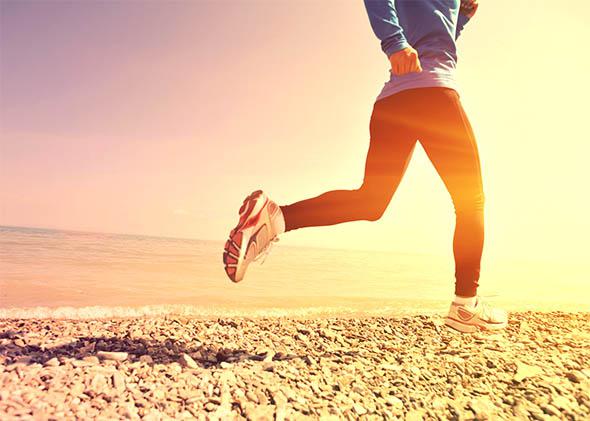Hi, I’m Jordan and I’m a runner.
I ran today and I ran yesterday. I’ll probably run tomorrow and maybe the day after. I often run alone, usually first thing in the morning. When I’m not running, I sometimes find myself thinking about running.
Is my running habit a problem?
Like many behaviors, running carries a potential for addiction. However, I’d classify myself as a running enthusiast. And it’s from that perspective that I want you to join me on the road.
In truth, I’d like for you to join me for several reasons.
Health is the first. The data in support of exercise, and particularly running, are irrefutable. If you run regularly, you’re likely to live a longer, healthier, and happier life. That doesn’t mean you have to run a marathon, or even a race, it just means you need to move every day.
Runners tend to live longer than nonrunning control groups, they tend to have lessened rates of depression and anxiety, lower blood pressure and cholesterol levels, lowered risk of stroke, even improved memory compared with nonrunning controls. Chronic diseases, even certain types of cancer including colon, breast, cervical, and ovarian, are less common in runners than the general population.
Simply stated, running makes and keeps people healthy. I’m a doctor, and I want my patients to live as long and disease-free as they can. Running three to four times per week helps make that happen.
Running is also a great investment. Despite spending almost $3 trillion per year, roughly 18 percent of our GDP, on health care, the United States is shockingly unhealthy. We spend almost two times more per capita than any country on health, yet we’re ranked 40th in life expectancy. It is estimated that more than half of our health care spending is related to the treatment of chronic, largely preventable disease. We are throwing billions of dollars at Type 2 diabetes and heart disease.
Since Hippocrates first diagnosed diabetes in ancient Greece many centuries ago, medicine has largely focused on disease treatment. When a patient has a heart attack, stroke, or fractured hip, we spend the majority of our resources treating the issue at hand. In these situations our system is incredible; with medical emergencies we are top-notch.
The problem, however, is that we spend fewer resources trying to prevent disease. Rather than paying trillions of dollars to treat medical problems, we could spend millions of dollars to help prevent them. Sound economic models exist for this strategy; we need to put these plans into action on a large scale.
Interestingly, private enterprise is leading the way. Companies across the spectrum of the business world have recognized the financial value of incentivizing wellness rather than paying for disease. Many are offering prizes, vacations, and most importantly lowered insurance premiums for employees who are active. Companies are using new fitness-tracking software to document activity, recognizing that active employees are healthier and more productive.
What if you hate running? When it comes to healthy running, the first issue is smiling. If you hate running, I want you to do something you like—riding a bike, skiing, swimming, rock climbing, even skipping. As long as you’re doing something that involves physical activity and intensity, I’m happy.
My main focus as a doctor who treats runners is keeping my patients on the road. In Running Strong I’ve tried to address every question that runners have, whether they want to train for their first 5K race and are trying to figure out how to get the right pair of shoes or are experienced marathoners looking to avoid injury and run faster. Everyone has questions, and my goal is to educate runners at their own level.
In today’s world, almost every patient who comes to the office has already consulted “Dr. Google.” The problem with Dr. Google as a diagnostician is that he’s only correct about 30 percent of the time, not a tremendously reliable source of information. But new technology can provide useful, personalized information, and that’s the part of my new book that is particularly exciting. Working in the fascinating space of augmented reality, my book allows readers to scan their smartphone over a topic of interest and obtain a virtual office consultation from anywhere in the world, 24/7, free of charge. I’m tremendously excited about the use of augmented reality as a way to educate people. You can see a bit about how this works and the philosophy behind Running Strong in the video below.
You can download the app, called Blippar, on your smartphone, point it at the book cover photo on your screen, and experience a trial of augmented reality for yourself.
The concept of the virtual office visit is to encourage educated self-treatment. As a sports medicine physician I’m not only interested in figuring out how to diagnose an injury but also how I can prevent it from recurring. The “stay off it until it gets better” approach generally isn’t the best medicine because it doesn’t address the injury cause. For example, the classic running injury called shin splints is most often due to faulty foot mechanics. If someone stops running, the shin pain generally goes away but quickly returns if the person runs again but hasn’t fixed the mechanical factors that lead to the injury. Teaching runners to visualize and better understand their injuries makes self-treatment much more effective. It also guarantees more precise information when it’s time to consult a physician in person.
With all that, let’s get moving! I’d love to see you on the road—walking, jogging, running, whatever you do is great. Encourage your friends and family to move, to do something that they enjoy. Think of movement as the most available and effective medicine known to humanity. Best of all, it’s free and works for everyone, young and old, rich and poor, anywhere in the world.
